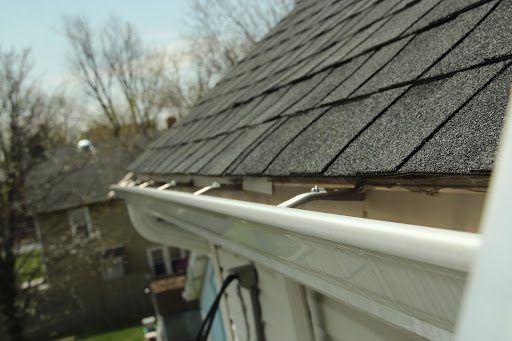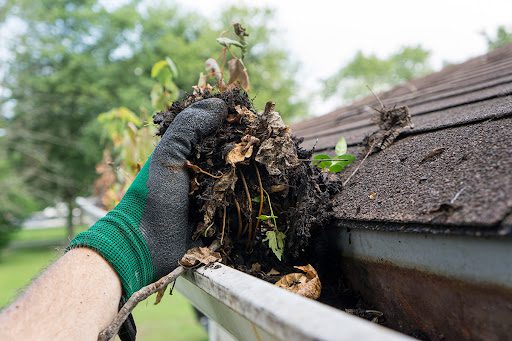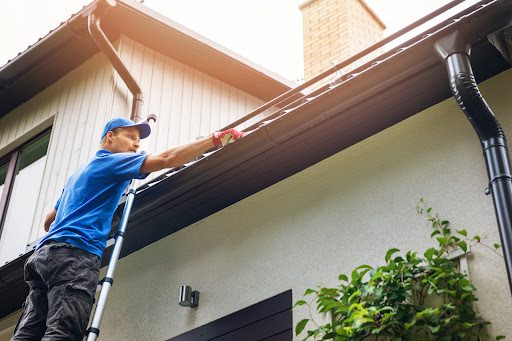WHAT IS THE BEST WAY TO CARE FOR YOUR HOME'S GUTTERS?


There are numerous benefits and perks of homeownership. However, for many homeowners, maintaining the gutters on their house is not high on the list of benefits. Although maintaining a home’s rain gutters is not usually an aspect of homeownership that many people enjoy, it is a crucial task that is required. Regular gutter maintenance is important to ensuring the integrity of your roof and, ultimately, the structure of your home. A clogged and unmaintained gutter system could lead to roof leaks and other issues that could mean significant and costly repairs.
As small as the gutters might be in respect to the rest of your home, they serve an important function and are an integral part of your home design. No matter what type of gutters you have, regular maintenance is crucial. A gutter system that is properly installed keeps the integrity of your home intact by draining rainwater away from your roof and preventing any unwanted and potentially costly water damage.
Gutters that are poorly maintained can malfunction and result in water damage that could flood your home’s basement, create issues with the foundation, lead to an accumulation of mold and mildew, and damage the siding and exterior boards. Additionally, gutters that fail could push water under your roofing shingles and create leaks and structural damage. Making sure that you maintain your gutters properly will help reduce the risks from water issues.
In general, you may be able to protect your wallet from costly roof leaks with a home warranty. When you purchase any plan from AFC Home Warranty, you have the option to add on additional coverage for roof leak protection. Since unexpected events like unpredicted heavy rain or storms can happen and no gutter system can prove to be absolutely effective all the time, it is best to consider protection with a home warranty. However, proper gutter care will help prevent many issues and unwanted expenses. Let’s take a look at some of the best gutter care.

Regardless of the residential roofing material or gutter system your home has, it is imperative that you clean your gutters regularly. Thorough gutter cleaning at least twice a year will help ensure that they continue to work properly. The best time to perform gutter cleaning is in the spring and fall. Cleaning after the spring will ensure that any debris or other materials from winter weather and spring storms will be removed. Fall cleaning will remove the leaves and other items dropped by trees and plants. Depending on where you live, you may need to perform a few cleanings in the fall if you have heavy leaf dropping. Also, you may need to do a cleaning following a big storm.
Cleaning is your number one line of defense in properly caring for your gutters and ensuring that they function correctly. As a result, you’ll want to make sure that you are doing it correctly. Make sure you have a good, sturdy ladder and always place it on a secure surface. You can use a ladder stabilizer for your safety and help prevent damage to the gutters from the ladder. You might also want to have someone assist you in case you need a hand with the ladder or need extra stabilizing support.
Before you clean the gutters, you need to remove any large debris or other objects that might restrict water flow. Regularly taking care of this will also help keep your gutters clean and prevent any insects or critters from nesting there. Keeping your gutters clear of any large items or bigger debris will help prevent a number of issues for your roof and home.
Once you have removed any large items from your gutters, you will need to remove the gunk and build-up. You can use a small scoop or hand shovel to remove the gunk. A child’s sandbox shovel would also work just fine. This step aims to remove the dead leaves, debris, and other things that have washed into the gutters. You might consider spreading a tarp underneath your workspace to collect all of the stuff you remove and protect your lawn and any landscaping.
When all of the leaves, pine cones, debris, and other gunk have been removed, you will want to flush out the gutters. You can use your garden hose and spray nozzle to wash out the gutters and downspouts. This will help clear any remaining gunk and ensure that your downspouts are unobstructed. Washing your gutters out will also show you if you have any leaks. If you have seamless gutters, you will only experience leaks from corrosion or deterioration of the materials. Homeowners with regular gutters may notice leaks around the seams and joints.
As discussed, regular gutter cleaning is a necessary chore that homeowners must do to prevent numerous issues, from roof damage to foundation water damage. Just as important, however, is regular gutter repair. Once you have cleaned out the gutters, you need to inspect them for any damage. If you find leaks or seams that have separated, you need to correct these problems. A seemingly small, insignificant gutter leak or clog can quickly result in serious damage and costly home repairs. You can seal leaks or failing seams with a patch kit or silicone caulk. You’ll want to ensure that your repairs are waterproof and adequate to keep your gutters in working order.
Over the course of your regular cleaning and gutter repair, you may also notice that your hangers have become worn or have failed. Your hangers keep your gutter system attached to the roof of your house. If your hangers have failed, you may see sections of your gutters that are sagging. When you are cleaning and doing annual repairs, you will need to correct any issues with hangers or sagging gutters. To be effective, your gutter system needs to be intact and attached evenly to your roof. You can install new hangers to reattach the gutters.

Your gutters perform the very important task of removing water from your roof and directing it away from your home. Gutters positioned with an appropriate slope will enable water to flow freely and drain correctly. If your gutters have become loose and have worked away from their original slope, you will have water drainage issues. A gutter without enough slope won’t move unwanted water away or may hinder drainage altogether. On the other hand, if a gutter has too much slope, the water may drain away too quickly and forcefully, which could damage your home’s exterior.
Experts suggest that your gutters have a slope of one-fourth of an inch for every 10 feet of gutter. You will want to ensure that you inspect your gutters regularly to check for an appropriate amount of slope. Checking the position of your gutters is part of your routine care and maintenance and will help ensure that you get the best results. Aside from the slope, you should also check for the right amount of tilt. Gutters that are leaning too far forward or backward will allow water to pool instead of drain correctly. The tile and slope of your gutters will need to be checked regularly for needed adjustment.
Depending on the type of gutters that you have, you might consider installing additional items like guards and downspout extensions. Gutter guards can help to minimize the need for numerous cleanings. These devices install over or just inside of your gutters and are designed to stop leaves, twigs, pine cones, and other debris from washing into your gutters. Newer construction homes might have gutter guards as a standard option. However, older homes and older gutter systems might not have any type of cap and guard to stop various items. With gutter guards installed, homeowners usually just need to brush the leaves and other items off the guards instead of scooping out the gutters.
Downspouts are designed to drain water from the gutters and funnel it away from your home. Usually, you will have a splash block at the end of each standard downspout that directs water a couple of feet from the home. Over time, however, these devices are prone to damage or displacement by heavy water flows. As a result, homeowners need to inspect splash blocks regularly and reposition them.
Improper splash blocks could allow water to pool around your foundation and enter your crawlspace. Instead of using traditional splash blocks, you might consider installing extensions. Extensions are flexible tubes attached to your downspouts and placed so that water flows farther away from your home and the foundation. Additionally, extensions can be repositioned to avoid water flowing in the same direction to the same spot. This can eliminate flooding on your property or damage to certain landscape elements. Extensions help your gutters drain more efficiently and away from your home.
If you’re looking for quality gutter guards for your home, we’ve partnered with Money.com to provide this list of trusted providers near you:
If you experience issues displaying the above table on your device, please click here.

If the idea of climbing on a ladder to the top of your roof with supplies in tow to inspect, clean, and de-clog your gutters sends you into a state of panic, you can always hire a professional. There are companies that specialize in this type of home maintenance and will take care of your gutters for you. Similar to having your HVAC serviced regularly, you can schedule annual cleaning and gutter repair. A gutter repair service with a reputable name can help you ensure that your gutters are cared for.
You can do an online search or ask community members and friends for recommendations of companies that will do a great job maintaining your gutters. When you contact a professional gutter service, you will need to give them the necessary information about the type of gutter system you have installed on your home. Gutter cleaning costs are usually based on the type of gutters you have and are calculated based on the linear footage and number of stories on your home. More than just cleaning services, you’ll want to ensure that any company you select will also inspect and repair your gutters unless you want to do that yourself.
Like many other things, time and age can take a toll on your gutters. In general, the most common type of gutters are made from galvanized steel and aluminum and have an average lifespan of 20 years. Other types of gutters made from copper and other high-end materials can last up to 50 years. If you’re experiencing frequent leaks or problems with gutter seams, you might consider upgrading for the sake of your home and roof.
New seamless gutters with guards can come with a 25-year warranty and require less maintenance and cleaning. New gutters can protect your roof and other parts of your home from costly damage by water. You will want to hire professional installers to ensure that your gutters are hung correctly. One of the best ways to care for your gutters is to make sure that they are installed properly for them to work correctly.
If you experience problems with your gutters, it could create roof leaks. While a home warranty doesn’t cover gutters, it can help cover the costs of repairs from a roof leak. Roof leak coverage will usually take care of issues if water makes its way under your shingles and causes damage to the structure. With AFC Home Warranty, you have the choice of four affordable plans that offer coverage across a wide range of systems, home appliances, and additional items.
With any of our plans, you have the option of adding additional coverage to protect against roof leaks. More than just a home warranty company, AFC Home Warranty offers one of the longest work guarantees in the industry, a 24/7 in-house service team, and additional savings on other products. Call AFC Home Warranty today to take advantage of our membership options.

Coverage not available in CA, WA and HI